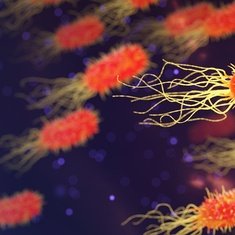|
Hint
|
Answer
|
|
The ability of a living thing to keep conditions inside its body constant
|
Homeostasis
|
|
Large molecule formed when many smaller molecules bond together
|
Polymer
|
|
The movement of materials (nutrients) in a local ecosystem
|
Nutrient Cycle
|
|
A living thing that has (or can develop) the ability to act or function independently
|
Organism
|
|
Having a pair of equal and opposite charges
|
Polar
|
|
Term referring to matter having an excess of electrons (a negative charge) or a deficiency of electrons (a positive charge)
|
Charged
|
|
A liquid substance capable of dissolving other substances
|
Solvent
|
|
A chemical bond that involves sharing a pair of electrons between atoms in a molecule
|
Covalent Bond
|
|
A major biotic community characterized by the dominant forms of plant life and the prevailing climate
|
Biome
|
|
A simple compound whose molecules can join together to form polymers
|
Monomer
|
|
An attraction between molecules of different substances
|
Adhesion
|
|
Attraction between molecules of the same substance
|
Cohesion
|
|
An organism that depends on complex organic substances for nutrition
|
Heterotroph
|
|
An organism that obtains energy by feeding on other organisms
|
Consumer
|
|
Any animal that feeds chiefly on grass and other plants
|
Herbivore
|
|
A gas that contributes to the greenhouse effect by absorbing infrared radiation
|
Greenhouse Gas
|
|
Process by which plants use the sun’s energy to convert water and carbon dioxide into sugars
|
Photosynthesis
|
|
The emission of water vapor from the leaves of plants
|
Transpiration
|
|
Water that leaks out and slowly moves deeper underground
|
Seepage
|
|
The process of wave-like muscle contractions of the alimentary tract that moves food along
|
Peristalsis
|
|
Protein substances that speed up chemical reactions
|
Enzymes
|
|
The cavity in which the large intestine begins and into which the ileum opens
|
Cecum
|
|
The energy that an atomic system must acquire before a process (such as an emission or reaction) can occur
|
Activation Energy
|
|
An enzyme secreted in the digestive tract that catalyzes the breakdown of fats into individual fatty acids that can be absorbed into the bloodstream
|
Lipase
|
|
An enzyme from the pancreas that digests proteins in the small intestine
|
Trypsin
|
|
Contains most of a cell’s genetic material in the form of DNA (deoxyribonucleic acid)
|
Chromosomes
|
|
All of the environments on Earth that support life
|
Biosphere
|
|
An organism that makes its own food
|
Autotroph
|
|
Cyclic movement of carbon in different chemical forms from the environment to organisms and then back to the environment
|
Carbon Cycle
|
|
An organism (like the earthworm) that feeds on decaying matter after it has been broken down by decomposers
|
Detritivore
|
|
Two strands of nucleotides wound about each other; structure of DNA
|
Double Helix
|
|
The variety of different types of genes in a species or population
|
Genetic Variation
|
|
An organism’s genetic makeup, or allele combinations
|
Genotype
|

